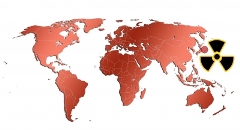Is Chancell or Angela Merkel responsible for the turn in German energy policy, or was the shift caused by journalists?
or Angela Merkel responsible for the turn in German energy policy, or was the shift caused by journalists?
This question may keep future historians busy, for they may never find a clear answer. Media researchers Hans Mathias Kepplinger and Richard Lemke (University of Mainz) provide the first hints after taking a close look at the media coverage of the Fukushima catastrophe in Germany, Switzerland, France and Great Britain, where the nuclear meltdown in Japan did not lead to a turning point in energy policy.
The researchers analyzed two large quality newspapers and the most important TV news shows in each country, which lead them to discover that the amount of coverage differed incredibly among the nations. During the first four weeks after the accident, German dailies and TV news presented 577 contributions dealing with Fukushima, in Switzerland 521, while in France 319 and in the UK only 271. Thus, the British journalists, compared to their German colleagues, dedicated less than half the amount of attention to the catastrophe.
Similarly dramatic are the differences in the evaluation and characterization of the event. The British and French media dedicated their attention to the accident in Japan itself. The German and Swiss media focused much more on the relevance of the accident domestically. Ninety percent of the analyzed contributions discussed the potential exit from nuclear energy and the moratorium. “Fukushima became a warning sign which demands political action as a consequence,” says Kepplinger. According to the researchers, the journalists primarily asked experts for statements to confirm their own opinions.
“The nations analyzed are equally far away from Japan and are not exposed to similar natural catastrophes like Tsunamis, the nuclear energy plants in these European countries have similar safety standards. Therefore, the excessive negative coverage in Germany and Switzerland cannot be explained by the ‘nature of the event,’” says Kepplinger. The differences in the emphasis and tone of coverage can likely be explained by “predominant long-term perceptions and opinions among journalists” in the four countries.
The following numbers mentioned by Kepplinger stimulate a bit of afterthought concerning the Fukushima media hype: The March 2011 submarine earthquake in Japan caused two catastrophes – “one extreme Tsunami which took a toll of approximately 30,000 human lives, and the accident in Fukushima which caused three deaths thus far and may cause an additional 100 – 1,000 cancer deaths.”
Birgit Stark, Melanie Magin and Stefan Geiss (all of them also working at the University of Mainz) tuned into a very different media hype. The media researchers analyzed how German news magazines Focus, Spiegel and Stern have reported on social networks in their print and online editions. They observed that journalists known to be frequent users of Twitter also report about the network very intensely. Concerning the frequency of reporting, Twitter comes close to Facebook. But only three percent of German Internet users are found on Twitter, while Facebook attracts at least 42 percent of users. Other networks like Stayfriends, Wer-kennt-wen or Xing – which attract up to 18 percent of German users – are scarcely mentioned in the mainstream media outlets analyzed.
Thus, there’s much hype in the old media pertaining to new media. The coverage of social networks is clearly biased, if mainstream media content is compared with the “real” user statistics. However, coverage of mainstream media does “steer the attention of media users to such topics,” according to Stark. If certain networks are being hyped or specific social changes are stated like self-fulfilling prophecies by journalists, this may have a real impact on society.
This contribution is the result of a seminar, entitled “Media Coverage of Journalism and Media Research” at the University of Mainz.
Published in Schweizer Journalist, Nr. 9+10.
Tags: Energy Policy, Fukushima, Hans Mathias Kepplinger, Media research, Richard Lemke, social networks, Twitter














































